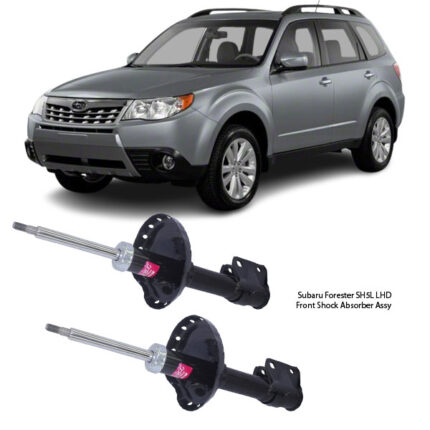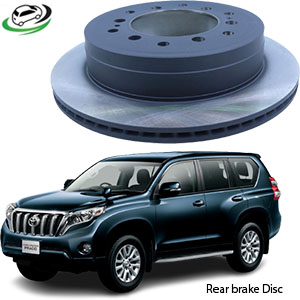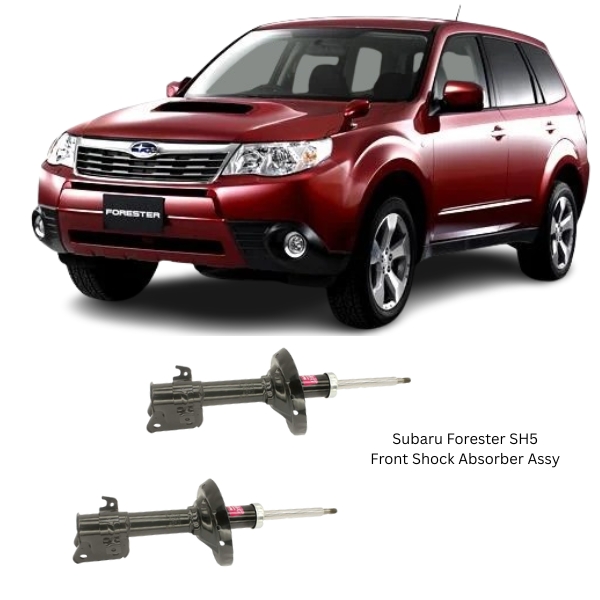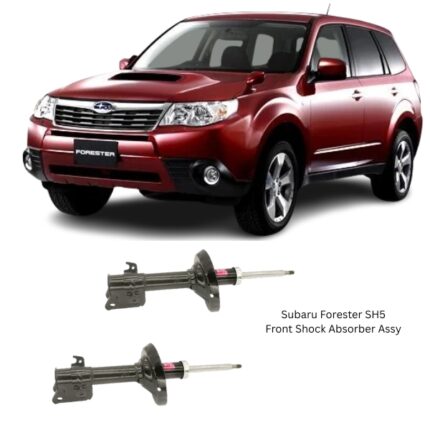Get Subaru Forester SH5 Front Shock Absorber Assy 339170 in Kenya
The Front Shock Absorber Assembly is one of the most critical components in a vehicle’s suspension system. Its primary function is to absorb and dampen the impact and vibrations caused by uneven road surfaces, potholes, bumps, and driving conditions. By doing so, it ensures vehicle stability, steering control, passenger comfort, and tire longevity. Without a properly functioning front shock absorber assembly, a vehicle would not only deliver a rough and uncomfortable ride but also face serious handling and safety issues.
1. Core Function of the Front Shock Absorber Assembly
The front shock absorber assembly is designed to manage the dynamic movement of the suspension and wheels. When the wheels encounter road irregularities, energy is generated through vertical motion. If left uncontrolled, this motion would cause the vehicle to bounce excessively, leading to instability. The shock absorber assembly converts this kinetic energy into heat energy through hydraulic fluid, which is then dissipated safely. This process controls suspension movement, minimizes vibration, and keeps the tires in constant contact with the road surface.
2. Main Components of the Assembly
The front shock absorber assembly is not just a single piece—it is a combination of several interconnected components that work together. These include:
-
Shock Absorber (Damper): The central cylindrical component filled with hydraulic fluid or gas. It provides resistance to compression and extension of the suspension.
-
Coil Spring: Surrounding the shock absorber in some designs (like MacPherson struts), the coil spring supports the vehicle’s weight and absorbs larger impacts.
-
Piston and Rod: The piston, connected to the rod, moves within the cylinder, forcing fluid through valves to provide damping.
-
Mounting Points/Top Mount: Secure the assembly to the vehicle’s chassis and suspension system. The top mount often includes a bearing to allow the strut to rotate with steering.
-
Dust Boot and Bump Stop: The dust boot protects the piston rod from dirt and debris, while the bump stop prevents metal-to-metal contact during full compression.
Together, these parts ensure proper functioning of the assembly and smooth operation of the suspension system.
3. Types of Front Shock Absorber Assemblies
There are several variations of shock absorber assemblies, each with distinct designs and advantages:
-
MacPherson Strut Assembly:
-
One of the most common types in modern vehicles.
-
Integrates the coil spring and shock absorber into a single compact unit.
-
Serves as both a shock absorber and a structural part of the suspension system.
-
-
Twin-Tube Shock Absorber:
-
Uses two cylindrical chambers: one for the piston and fluid, the other for excess fluid and air.
-
Provides balanced performance and durability.
-
-
Mono-Tube Shock Absorber:
-
Contains a single tube with gas and fluid separated by a floating piston.
-
Offers better heat dissipation and more consistent performance.
-
-
Gas-Charged Shock Absorber:
-
Uses pressurized nitrogen gas to reduce aeration of hydraulic fluid.
-
Improves responsiveness and reduces shock fade.
-
4. Role in Driving Safety and Comfort
The front shock absorber assembly plays multiple critical roles:
-
Stability Control: By keeping the wheels in contact with the road, it improves braking performance and prevents skidding.
-
Steering Precision: Ensures responsive and accurate steering, especially during sharp turns.
-
Passenger Comfort: Absorbs vibrations and jolts to provide a smoother ride.
-
Tire Protection: Prevents uneven tire wear by maintaining consistent tire-to-road contact.
-
Load Handling: Helps distribute vehicle weight evenly, reducing strain on other suspension parts.
5. Signs of a Worn or Faulty Front Shock Absorber Assembly
Since shock absorbers degrade over time, recognizing symptoms of wear is crucial. Common signs include:
-
Excessive bouncing after hitting a bump.
-
Uneven or rapid tire wear.
-
Longer braking distance.
-
Fluid leaks from the shock absorber body.
-
Knocking or clunking noises while driving over uneven roads.
-
Poor steering response or drifting during turns.
Ignoring these signs can compromise vehicle safety and lead to costly repairs in other suspension or steering components.
6. Materials and Construction
The front shock absorber assembly is engineered with high-strength materials to withstand continuous stress and harsh conditions.
-
Piston Rod: Typically made from hardened and chrome-plated steel for durability and corrosion resistance.
-
Cylinder/Body: Constructed from reinforced steel or alloy to contain hydraulic pressure.
-
Coil Spring: Manufactured from tempered high-carbon steel for resilience and long life.
-
Mounts and Bushings: Made from heavy-duty rubber or polyurethane to absorb vibrations and provide flexibility.
This robust construction ensures longevity, safety, and optimal performance.
7. Maintenance and Replacement
Shock absorber assemblies are not usually serviceable, meaning once they wear out, they must be replaced as a unit. Regular inspections are essential, especially after 50,000–80,000 kilometers of use, depending on driving conditions. Off-road driving, rough roads, or carrying heavy loads accelerates wear.
Maintenance Tips:
-
Inspect for fluid leaks and cracks in the dust boot.
-
Check for unusual noises or vibrations while driving.
-
Replace in pairs (both front assemblies at the same time) to maintain balance.
-
Use professional alignment after replacement to ensure correct suspension geometry.
8. Installation Considerations
Replacing a front shock absorber assembly requires technical expertise. Key steps in installation include:
-
Properly supporting the vehicle to prevent accidents.
-
Compressing the coil spring safely when separating it from the old assembly.
-
Ensuring correct torque specifications on bolts and nuts.
-
Performing wheel alignment after installation.
Incorrect installation can lead to suspension failure, poor handling, or even accidents.
9. Advantages of a Quality Front Shock Absorber Assembly
Investing in a high-quality assembly offers numerous benefits:
-
Enhanced ride comfort and reduced driver fatigue.
-
Better vehicle handling on sharp turns and rough roads.
-
Improved braking efficiency and shorter stopping distance.
-
Longer tire life and reduced maintenance costs.
-
Increased safety for passengers and cargo.
10. Application Across Vehicles
While the specific design may vary, front shock absorber assemblies are essential in nearly all vehicles—sedans, SUVs, trucks, and commercial vehicles. Each is tailored to the vehicle’s suspension design, weight distribution, and intended use.
Follow us on Facebook for more parts.




